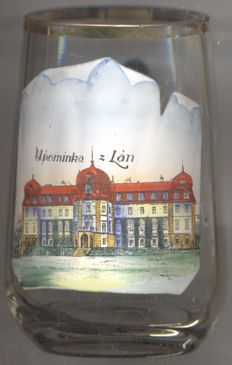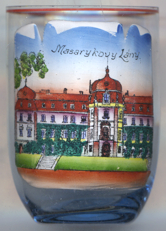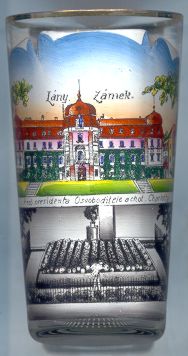

|
| ČESKÁ REPUBLIKA | CZECH REPUBLIC |
| Středočeský kraj | Central Bohemia region |
| Okres: Kladno |
Lány is situated at an elevation of 418 m in the area between the Křivoklátsko (Pürglitzer Wald) nature reserve and the Kladno basin. In 2007 Lány was separated from the Rakovník district and was incorporated into the district Kladno.
Lány was first mentioned in 1392. For centuries, the region was a favoured hunting place for the regents of Bohemia. In 1587 Lány was acquired by Emperor Rudolf II who converted the castle to a hunting lodge. The domains became part of the principality of Křivoklát, a possession of the Emperor as King of Bohemia. Although Emperor Karl IV had stipulated in 1348 that Křivoklát must not be separated from the Bohemian Crown, Emperor Leopold I sold the principality in 1681 to the Wallenstein (Waldstein, Waldštejn) family. However, the purchase contract also required that the Waldsteins had to maintain the grounds for the Royal hunts. When poaching had become a serious problem, an area of 9,600 ha was enclosed in 1713 by a palisade fence of a length of 46 km. In 1731 Křivoklát with Lány passed to the Princes of Fürstenberg. The game reserve was replaced in 1736 by two separate reserves, one for big game at Lány (3,000 ha) and one for wild boars at Řevnice. The reserve at Řevnice does not exist any more; wild boars were introduced into the game reserve of Lány in the 20th century. The horse carriage railway from Prague via Vejhybka (Kladno) to Lány was built in 1827–1830. The original plans for an extension of the line to Plzeň were, however, never completed. It was the second horse carriage railway in Europe after the line from České Budějovice to Linz, which had been constructed in 1825–1832.


 Lány castle [left, no. 4733, right, no. 4607, and below no. 1997: top picture]
goes back to a stronghold of the Romanesque period.
Emperor Rudolf II acquired Lány in 1589 and had the castle rebuilt into a hunting château.
The Fürstenbergs then rebuilt the château in Baroque style.
The château was purchased by the Czechoslovak state in 1921. Since then it is the residence of the
Presidents of the Republic. The palace gardens were laid out during the 18th century. Its present design was
shaped in 1921–1930. One of the architects responsible for this design was the famous Slovenian architect
Jože Plečnik.
Lány castle [left, no. 4733, right, no. 4607, and below no. 1997: top picture]
goes back to a stronghold of the Romanesque period.
Emperor Rudolf II acquired Lány in 1589 and had the castle rebuilt into a hunting château.
The Fürstenbergs then rebuilt the château in Baroque style.
The château was purchased by the Czechoslovak state in 1921. Since then it is the residence of the
Presidents of the Republic. The palace gardens were laid out during the 18th century. Its present design was
shaped in 1921–1930. One of the architects responsible for this design was the famous Slovenian architect
Jože Plečnik.

The bottom picture on glass no. 1997 [left] shows the  tomb of President Tomáš
Garrigue Masaryk and his wife Charlotte. Masaryk was born in 1850 in Hodonín.
In his youth he worked as a blacksmith and later studied philosphy at the universities of Brno,
Vienna and Leipzig. In 1882 he gained an appointment as professor of
philosophy at the university of Prague. Masaryk served in the Austrian parliament in 1891–1893
and 1907–1914 becoming a proponent of the independence of the Slavic peoples from the Austro-Hungarian Empire. When
World War I broke out, Masaryk fled to Geneva, to Italy, London,
Russia, and finally to the United States. In October of 1918 he visited Philadelphia where the
Proclamation of Independence of the Czechoslovak Republic was to take place at Independence Hall. Masaryk was elected three
times, in 1920, 1927 and 1934, and held this office until his resignation due to severe illness in December 1934. In 1878,
New York, Masaryk had married the American Charlotte Garrigue, from whom he took his middle name.
Charlotte died on the 13th of May, 1923, and was interred in the cemetery of Lány. Tomáš Garrigue Masaryk
died at Lány on the 14th of September, 1937.
tomb of President Tomáš
Garrigue Masaryk and his wife Charlotte. Masaryk was born in 1850 in Hodonín.
In his youth he worked as a blacksmith and later studied philosphy at the universities of Brno,
Vienna and Leipzig. In 1882 he gained an appointment as professor of
philosophy at the university of Prague. Masaryk served in the Austrian parliament in 1891–1893
and 1907–1914 becoming a proponent of the independence of the Slavic peoples from the Austro-Hungarian Empire. When
World War I broke out, Masaryk fled to Geneva, to Italy, London,
Russia, and finally to the United States. In October of 1918 he visited Philadelphia where the
Proclamation of Independence of the Czechoslovak Republic was to take place at Independence Hall. Masaryk was elected three
times, in 1920, 1927 and 1934, and held this office until his resignation due to severe illness in December 1934. In 1878,
New York, Masaryk had married the American Charlotte Garrigue, from whom he took his middle name.
Charlotte died on the 13th of May, 1923, and was interred in the cemetery of Lány. Tomáš Garrigue Masaryk
died at Lány on the 14th of September, 1937.
The former German name of Lány, Lana, also is the name, both in Italian and in German, of Lana, Italy.
![[scale]](lineal.jpg)